An In-Depth Beginner's Guide to Skateboarding
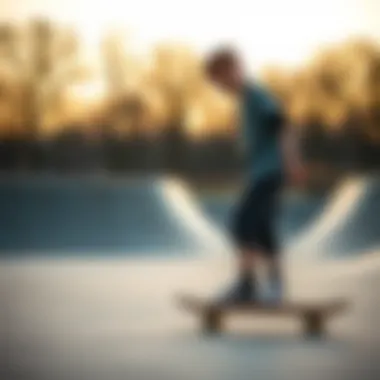
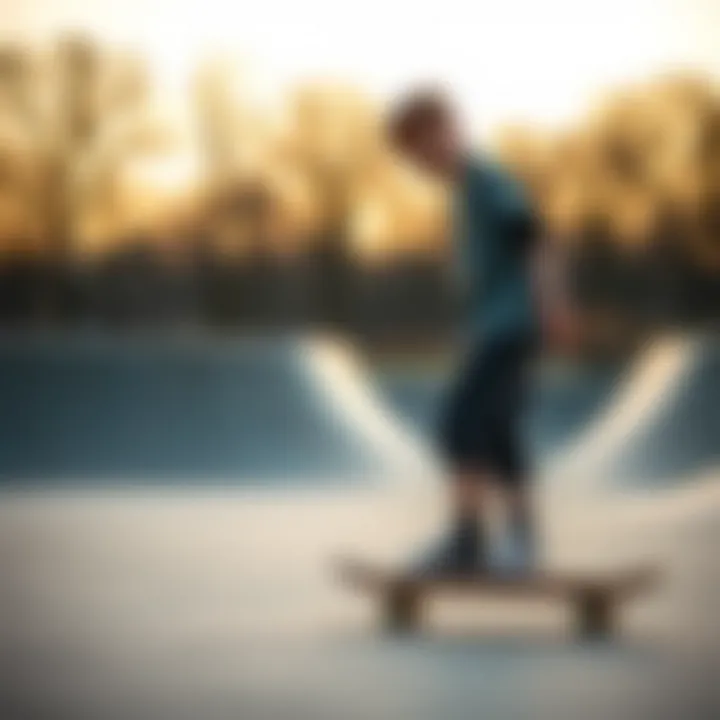
Intro
Skateboarding is not simply a sport; it embodies a lifestyle, a culture, and a journey into self-expression. For many, the first skateboard serves as a key that unlocks an exciting world where creativity and movement intertwine. As someone who took their first ride not so long ago, I can appreciate the overwhelming combination of excitement and trepidation that comes with starting out. Whether you’re eyeing your very first board or seeking to refine your skills, understanding the essentials is crucial.
Gear Reviews
Understanding your gear is the first step to successfully navigating your skateboarding journey. The right equipment enhances skills, boosts confidence, and ensures safety while you ride.
Skateboard Essentials: Decks, Trucks, and Wheels
When it comes to skateboards, the deck is your foundation. Selecting the right deck involves considering your foot size, riding style, and intended use, like skate parks or street skating. A wider deck typically offers more stability, while a narrower one can help with tricks. Popular brands, such as Element and Santa Cruz, provide quality options across various styles and preferences.
Next up are trucks, the metal parts that connect your wheels to the board. They determine how your board turns and reacts when you push off or land tricks. While some skaters prefer the nimble nature of lighter trucks, a heavier setup might offer stability for those entering new terrains.
Lastly, wheels round out this triad. The hardness and size of your wheels significantly affect how your board rides. Softer wheels, generally measuring around 78A to 87A, provide a smoother ride over rough surfaces. Conversely, harder wheels, around 88A and above, are excellent for smooth concrete but can be jarring on uneven ground.
Safety Gear: Helmets, Pads, and Protective Equipment
Safety should never take a back seat. Investing in quality safety gear is essential, especially for beginners, who’ll find themselves practicing falls just as much as tricks. A reliable helmet, like those from Pro-Tec or Bell, is non-negotiable; think of it as your first line of defense.
Wrist guards and knee pads often come highly recommended. They absorb impact and decrease the likelihood of injuries during practice sessions. While it might seem cumbersome at first, adapting to safety gear is part and parcel of becoming a skater. Most importantly, skateboarding is meant to be enjoyed, and safety gear frees you to ride with confidence.
Remember, while it can feel awesome to go out without protection, it's better to be safe than sorry!
Technique Guides
After gearing up, what’s next? Mastering the fundamental skills of skateboarding unlocks a world of possibilities.
Fundamental Skills for Beginners: Stance and Balance
Every skater starts with the basics: learning to stand properly on the board. Generally, skaters fall into two categories: regular or goofy footed. Your stance is determined by which foot you prefer at the front: if you push off with your left foot, you’re likely regular; if it’s your right, you’re goofy.
Finding your balance really is the backbone of skateboarding. Simple exercises like riding on flat surfaces can help build confidence. Try gliding with one foot on the board to get comfortable with shifting your weight.
Advanced Tricks: How to Master Board Slides and Ollies
Once you’ve refined your balance, it’s time to look toward the more thrilling aspects of skateboarding: tricks. Board slides are a good starting point for those ready to take their skills a step further. They can often look daunting, but with repetition and perhaps a few failed attempts, they become more manageable.
Ollies, the cornerstone of many tricks, allow skaters to leap while keeping their board in tow. Start with a gentle pop and drag your back foot up the tail. The trick is in the timing – practice makes perfect.
Exploring skateboarding’s many layers and finding your individual style should be an exciting part of your journey. As you progress, take the time to connect with local skater communities through platforms like reddit.com or local skate parks to share experiences and tips.
Preamble to Skateboarding and Its Culture
Skateboarding is not just a sport; it's a vibrant subculture that has grown from the streets to global arenas. Understanding this culture provides a peek into a world where creativity and individuality reign. Skateboarding weaves itself through music, fashion, and art, influencing countless lives and trends. For anyone looking to step onto a board, grasping this context is crucial. It sets the stage for what lies ahead, enriching the experience and framing the challenges ahead with a sense of community.
Historical Context of Skateboarding
Skateboarding's origins can be traced back to the late 1940s and early 1950s in California. Surfer culture heavily influenced its birth, as riders sought something to mimic their ocean rides on land. The early boards were simple, made from wooden crates with wheels attached; think of those retro vibes, yet powerful enough to spark a whole movement. As the 1960s rolled in, companies like Makaha began producing the first commercial skateboards. The progression from crude backyard experiments to recognized sports equipment was remarkable. By the 1970s, skateboarding morphed, with iconic figures like Tony Hawk reshaping the sport into what it is today. From downhill racing to vert ramps, each era brought innovative styles and techniques, embedding skateboarding into American culture.
Significance of Skateboarding in Contemporary Society
Today, skateboarding holds a significant place in contemporary society. It serves various purposes, from recreation to self-expression. Many individuals perceive skateboarding as a medium for freedom, taking to the streets to escape mundane routines. The rise of social media has amplified this, allowing skaters to showcase their skills, connect with communities, and inspire others.
In urban environments, skateboarding often challenges ordinances and city policies, promoting discussions about public spaces and their accessibility. The emergence of skate parks highlights a recognition of the sport's value; these spaces provide safety and outlets for creativity. The sport transcends age, gender, and economic boundaries, uniting diverse individuals under the banner of skate culture. Skaters often grapple with stereotypes, yet their resilience fosters camaraderie that echoes through the wheels they ride on.
In sum, skateboarding is more than a pastime; it's a catalyst for cultural dialogue, connecting people across varied backgrounds, and promoting a spirited lifestyle that continues to evolve.
Understanding the Basics of Skateboarding
Diving into skateboarding without grasping the fundamentals can be like jumping into the deep end of a pool without knowing how to swim. It's crucial to understand the basics because they form the cornerstone of every skater's journey. By mastering these essential elements, you increase your confidence, reduce frustration, and most importantly, boost your enjoyment. Here, we’ll break down the anatomy of a skateboard and discuss the different types available, giving you a robust foundation to build upon.
Anatomy of a Skateboard
Understanding a skateboard’s anatomy is like knowing the different parts of a car. If something goes wrong, having that knowledge allows you to troubleshoot effectively. Each component plays a distinct role in how the board performs. Let's break this down further.
Deck
The deck is the flat part of the skateboard, where you place your feet. Typically made of seven-ply maple wood or a composite material, the deck's design can drastically affect your riding experience.
A well-constructed deck has a slight upward curve at both ends which is known as a "kicktail." This feature is vital for performing tricks and aiding in pushing off the ground. A longer deck might be beneficial for stability if you are just getting started, while a shorter one allows for more maneuverability, ideal for tricks. The material choice and deck shape influence not only durability but also how the skateboard feels underfoot.
Trucks
Trucks are the metal parts that sit on top of the deck, holding the wheels in place. Think of them as the skateboard’s backbone, affecting how it turns and how responsive it feels. Most beginners opt for aluminum trucks due to their combination of strength and lightweight characteristics.
A noteworthy feature is the adjustable bushings; these can make turning easier or harder depending on your preference. Choosing the right truck width is equally essential, as it should match the width of your deck to ensure balanced performance. An improperly fitted truck can lead to unstable rides, which isn’t fun when you’re just starting out.
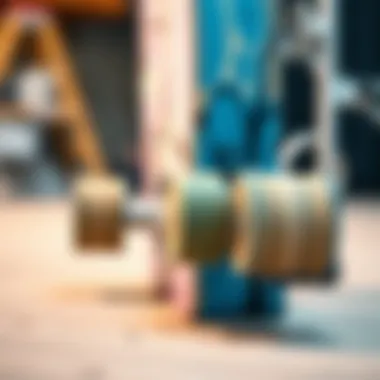

Wheels
The wheels are essential for movement. Made from urethane, they come in various diameters and hardness levels. Softer wheels (78A to 87A) provide a cushioned ride and are great for cruising. Harder wheels (88A and above), on the other hand, are excellent for grinding and tricks on smoother surfaces.
Also, the wheel size matters; larger wheels, generally over 55mm, are suitable for rough terrains, while smaller wheels offer maneuverability and are better for tricks. Choosing the right wheels can greatly enhance your skateboarding experience.
Bearings
Bearings are what allow the wheels to spin. They sit inside the wheel and, when properly maintained, are crucial for a smooth roll. Most skateboard wheels use 608 bearings, which are a popular size offering a balance between speed and control.
Another critical aspect is the bearing rating system known as ABEC (Annular Bearing Engineering Committee). Higher ABEC ratings mean tighter tolerances and, generally, smoother spins. However, many skaters find that the difference in performance is negligible for beginners. It’s more about what feels right for you.
Types of Skateboards
Now that we know what goes into a skateboard, let’s explore the various types available. Each type serves a unique purpose and is geared towards different skating styles.
Standard
Standard skateboards are what most beginners think of when entering the sport. They typically feature a flat deck and are versatile enough for tricks or cruising around town. The convenience of a standard skateboard is that it's easy to learn the basics and gradually build skills.
However, they may not be the most comfortable on rough patches, giving a bumpy ride. If you’re primarily cruising, you might consider something with a softer setup.
Longboard
Longboards stand out with their length and shape. They are designed for smooth rides over long distances, making them popular for commuting or downhill racing. The elongated design provides stability during high speeds and eases the strain on the legs when pushing.
Though, they typically aren’t as suitable for tricks as a standard skateboard, limiting their appeal if you're aiming to dive into more technical maneuvers. Still, longboards offer a different riding experience that many riders fall in love with.
Cruiser
Cruisers are a blend between comfort and maneuverability. They usually feature a shorter deck and softer wheels, making them perfect for getting around the city or for casual rides. Their compact design means they are easy to carry.
However, cruisers might not have the same trick potential as standard boards, which could be a downside if you're looking to showcase your skills. Nonetheless, for those who seek an enjoyable ride without too much fuss, a cruiser is aces.
Each of these board types has its unique appeal and caters to different skating needs. By understanding the anatomy and the options available, you’re setting yourself up for not only participation but enjoyment in the world of skateboarding.
Choosing Your First Skateboard
Choosing your first skateboard is akin to picking out a partner for a dance; the right fit makes all the difference. Your skateboard will be an extension of your personality and skill level, which is why understanding the essentials before making that purchase is paramount. The world of skateboarding can seem a bit daunting at first, but knowing what to look for can make the experience much smoother. Factors such as your skill level, budget, and chosen style of skating play a crucial role in your decision-making process.
Factors to Consider
Skill Level
Your skill level is one of the most critical aspects to keep in mind when choosing a skateboard.
Beginner skaters often require boards that provide a stable foundation. A wider deck, for instance, offers greater control, which is beneficial for new riders still working on their balance. This stability not only alleviates fear but also accelerates the learning curve. However, opting for a board that’s too wide can make tricks more challenging as your skills develop. Finding the right balance is key.
For intermediate skaters, the dynamics shift slightly. They may want a board that allows for both stability and agility, providing room for more advanced tricks without compromising control. As such, selecting a skateboard tailored to your current skill set can significantly enhance your experience.
Budget
When it comes to budgeting, many skaters start with a modest financial commitment. Some may think that an expensive board guarantees better performance, however, this isn’t always the case. You can find a solid skateboard for beginners in the range of $100 to $200. Skaters should always weigh the cost against the quality of materials used and brand reputation.
Investing a bit more up front can sometimes save money over time by avoiding frequent replacements. On the flip side, splurging on high-end boards that haven’t been fully utilized can lead to buyer’s remorse. The idea is to find something within budget but high enough in quality that meets your needs without breaking the bank.
Style of Skating
Style of skating is often an unspoken reflection of your tastes and interests. Whether you’re into street skating, vert, or longboard cruising, each style requires different board characteristics. For instance, street skaters generally gravitate toward popsicle-shaped boards which facilitate tricks on ledges and rails.
Longboarders, on the other hand, prefer wider decks for better grip and stability during downhill rides. Each choice comes with its own advantages; street boards are lightweight and portable, while longboards provide a smoother ride and ease of control during downhill sessions.
Ultimately, understanding how you want to skate is crucial. If you’re unsure which style to delve into, consider trying a few different boards at your local skate shop.
Top Brands in the Market
When searching for the right skateboard, familiarity with the brands can be a game-changer. Companies like Element, Santa Cruz, and Almost offer a mix of affordability and quality perfect for beginners. Investing in a trusted brand can make you feel more comfortable and confident in your choice. Make sure to read reviews, check forums, or even visit local skate shops to feel the boards in person. Many shops allow you to test ride different models, giving you a better grasp of what works for you.
Fundamental Skateboarding Techniques
Understanding fundamental skateboarding techniques is crucial for anyone looking to embrace this exhilarating sport, especially for newcomers. These techniques create the groundwork for progression, turning what might seem daunting at first into an approachable learning curve. Mastering basic skills not only boosts confidence but also enhances safety while skating, making it essential for both enjoyment and longevity in the sport. The techniques discussed here—balancing, pushing, stopping, turning, and carving—are the building blocks of a successful skateboarding experience.
Balancing on the Board
When you first step onto a skateboard, balancing can feel like walking a tightrope. The board becomes an extension of your body, and learning to find your center of gravity is the key. To hone this skill, start by standing still on the skateboard with one foot near the tail and the other foot near the middle of the deck. Focus on keeping your knees slightly bent and your weight centered.
Practicing on a smooth surface helps too. If you have access to a quiet, flat area like a parking lot, it’s ideal. Gradually shift your weight from foot to foot, or you can experiment with lifting one foot slightly off the deck to get used to the board’s movement.


Benefits of mastering balance:
- It allows for smoother rides.
- Improves control over the skateboard in various situations.
- Reduces the likelihood of falls.
Start small, and before you know it, you'll be carving around like a pro.
Pushing and Stopping
Once you feel steady on your board, the next step involves pushing off to gain momentum. Position your front foot near the front bolts and use your back foot to push off the ground. It’s all about rhythm; find a comfortable push-and-glide pace that feels natural. You will begin to familiarize yourself with how much force to apply for desired speed.
Stopping is just as crucial as pushing. There are several methods to come to a stop:
- Foot brake: Drag your back foot gently against the ground while leaning back for balance.
- Heel drag: Lift your back foot and let your heel touch the ground to slow down gradually.
- Slide stop: This technique requires a bit more skill, where you slide the tail of the board, but it’s effective when done correctly.
Why these techniques matter:
- Allow skaters to control their speed.
- Help in navigating busy environments, improving safety.
- Essential for merging into a community of skaters who share these fundamentals.
Turning and Carving
Now that you've practiced balancing, pushing, and stopping, it’s time to explore turning and carving. These maneuvers not only help in navigating your surroundings but also enhance your overall skating fluidity.
To turn, lean your body weight in the direction you want to go; for instance, lean forward and to the right to make a right turn. You can also use your legs to pivot by shifting your weight onto your toes or heels. This is where the word "carving" comes into play; it allows you to make smooth, sweeping turns, akin to skiing down a hill. Initiating a carve involves shifting your weight to your toes or heels while maintaining a slight bend in your knees.
Here's a quick guide to get you started:
- Weight Distribution: Lean into the turn, keeping your knees bent.
- Practice Repeatedly: Find a flat area and practice tighter and wider turns.
- Feel the Flow: As you grow comfortable, playing with your speed alongside your turns can bring a whole new element to your skating.
Importance of turning and carving:
- Creates a sense of freedom and control.
- Enables you to navigate obstacles efficiently.
- Enhances your overall style and flow as a skater, which is greatly appreciated in skate culture.
Safety Measures for New Skaters
Safety measures are paramount for anyone stepping onto a skateboard, especially for newcomers who are just finding their footing in this sport. Understanding safety gear and injury prevention strategies is crucial. It sets the stage for a positive experience, allowing skaters to focus on learning and enjoying the ride rather than worrying about potential mishaps. As it’s often said, “better safe than sorry,” and this rings especially true in a sport that has its fair share of spills.
Essential Protective Gear
Helmets
Helmets are perhaps the most critical piece of protective gear for skaters. They protect the most important part of your body — the noggin. A well-fitted helmet can significantly reduce the risk of severe head injuries in case of falls. When choosing a helmet, look for something that meets safety standards, like CPSC or ASTM certifications. A key characteristic of helmets is that they should sit snugly on the head without moving when you shake it. There are various styles available, from classic skate designs to more streamlined, modern looks. Each has its pros and cons.
One unique feature to consider is the inner foam lining, which absorbs impact. The thinner the helmet, the lighter it tends to be, but might not offer the same protection level as a bulkier option. So, it’s a balancing act — you want comfort without compromising safety.
Wrist Guards
Wrist guards serve as a safety net for one of the most commonly injured areas in skateboarding — the wrists. When falling, skaters often extend their hands to break the fall, leading to sprains or fractures. A strong wrist guard absorbs impacts that could otherwise lead to injury. They typically feature a plastic splint on the palm side and are designed to keep the wrist straight during a fall.
Their main appeal is their versatility; they can fit under gloves and are usually adjustable, making them a beneficial choice for both beginners and seasoned skaters. However, one downside is that they might limit wrist movement slightly, which can be a drawback for some when trying to perform tricks.
Knee Pads
Knee pads offer another layer of protection for new skaters. They are designed to cushion and shield the knees from hard impacts or abrasions when hitting the ground. A good pair of knee pads usually come with a hard outer shell and foam padding within, providing a solid defense against rocky terrain.
The key characteristic of knee pads is their adjustability. They can fit snugly over most clothing and allow for freedom of movement while skating. One unique aspect to note is that they can sometimes feel bulky. Therefore, finding a comfortable fit that meets your mobility needs is essential, especially for beginners who may feel self-conscious when starting out but want to skate confidently.
Understanding Risk and Injury Prevention
Even with proper gear, understanding risk and injury prevention techniques is vital. Skateboarding, while thrilling, comes with its own set of risks. This means becoming familiar with your surroundings, knowing the capabilities of your skateboard, and recognizing your skill level before trying new tricks or navigating tricky terrain.
Start slow, practicing in safer environments like parks designated for skating, where the risk of falling is mitigated by softer surfaces.
Engaging with the skate community can also provide vital knowledge. Experienced skaters often share tips on getting back up after a fall, keeping one’s balance, or mastering basic techniques.
"Skateboarding isn’t just a sport; it’s a culture where sharing experiences can foster growth and safety."
By understanding and respecting safety measures, newcomers can embark on their skateboarding journey with confidence. It's not just about avoiding injuries; it’s about enhancing the overall enjoyment and extending one’s passion for skating.
Exploring Skate Parks
Skate parks are not just mere concrete wonders; they’re arenas where culture, skill, and community collide. For those venturing into skateboarding, understanding skate parks is pivotal. These spaces provide an opportunity to practice skills, learn new tricks, and meet like-minded enthusiasts. It's common to hear a skater say, "You find your crew at the park," which underlines the social aspect of this sport. The value of skate parks transcends just being places to ride; they are integral to a skater's growth and connection to the broader skateboarding community.
Choosing the Right Skate Park
Selecting a suitable skate park involves several considerations. Not all parks are created equal, and each has its unique challenges and vibes. Some aspects to look at include:
- Skill Level Compatibility: Newbies may benefit more from parks designed for beginners. Look for smoother transitions and less steep ramps when starting out. Conversely, advanced skaters might seek out parks with complex features to challenge their skills.
- Amenities: Check if the park offers essentials like seating areas, restrooms, and even water fountains. Parks that enhance comfort can make your skating experience more enjoyable.
- Crowd Dynamics: Every park has its peak hours. It might be a good idea to visit during off-peak times when there are fewer skaters. This way, novices can practice without the pressure of a bustling crowd.
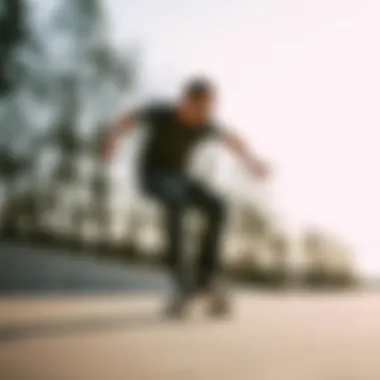
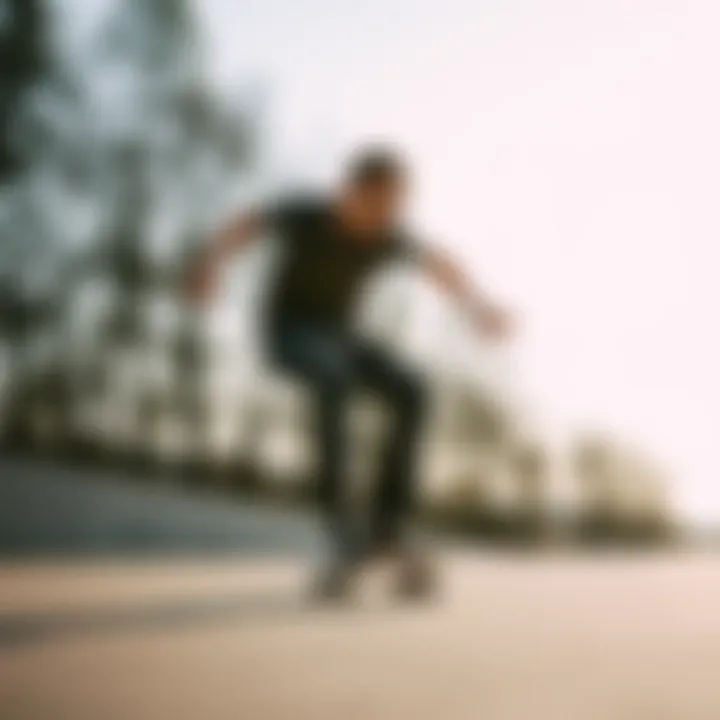
By assessing these factors, skaters can find a park that feels right for them, allowing for more joyful practice sessions.
Navigating Social Dynamics at Skate Parks
Interacting in skate parks requires a certain finesse. Skate culture has its own lingo and unwritten rules, which newcomers must learn over time.
- Respectful Attitude: If you see others waiting for a turn, it’s courteous to acknowledge them. You might hear, "No cuts, no buts," emphasizing the need for fairness. Being friendly and cheering on fellow skaters helps foster a supportive environment.
- Observe Before Engaging: When stepping into a new park, watch the flow. Observing can provide insights into the park's dynamics and how established skaters interact. It’s often said that actions speak louder than words, so showing respect through your skateboarding can earn you respect in return.
- Be Open to Friendship: The park can be a breeding ground for new connections. Don’t hesitate to strike up a conversation or ask for tips. Many skaters are keen to share their knowledge or even show you a trick or two.
"Skate parks are classrooms where learning, mixing, and growing happen naturally."
Overall, navigating the social dynamics of skate parks is about striking a balance between confidence and humility. Building relationships in these spaces can enrich your skateboarding journey and make you feel part of something bigger than just the act of skating.
The Role of Community in Skateboarding
Skateboarding is not just about the tricks, the board, or the intense rush of gliding down a half-pipe. At its core, it thrives on the bonds formed among skaters. The community around skateboarding serves as both a support system and a cultural hub. Newcomers often find themselves enveloped in this camaraderie, which can drastically shape their skateboarding journey.
Building connections within the skateboarding community creates an environment rich in learning and encouragement. Whether it’s sharing a tip on how to land a trick or just laughing off a crash, these interactions lay the groundwork for friendships that often last a lifetime. Meeting like-minded individuals who share the same passion can instill a sense of belonging. The culture encourages collaboration rather than competition. As newer skaters navigate their own learning curves, they quickly realize that helping one another is a cornerstone of skateboarding culture.
Building Connections and Friendships
Establishing bonds with fellow skaters can help to enrich one’s experience. It’s in skate parks and on sidewalks where relationships form, often through shared experiences and mutual goals.
- Exchange of Skills: An experienced skater might take time to guide a novice, demonstrating perseverance and showing how to master a challenging trick.
- Encouragement and Motivation: When framed by peers in the community, even failures become stepping stones. The encouragement from skate buddies can push someone to try that new move they’ve been eyeing.
- Social Gatherings: From casual meet-ups to more organized events, these gatherings can deepen bonds. It could be as simple as sharing a session at the local park or attending a major skate competition together.
Such gatherings often strike a balance between competition and camaraderie. They provide a platform where the excitement of friendly rivalry flourishes, pushing each skater to elevate their skills while celebrating each other's accomplishments.
Local Skateboarding Events and Competitions
Participating in local events is like joining a rite of passage for many skaters. These competitions serve not only as a proving ground for skills but also as a festival of community spirit. Much more than just competitions, these events strengthen the local scene in various ways.
- Showcasing Talent: Events are perfect for skaters to show off their abilities in a supportive environment. Winning isn't the only goal; many skaters find joy in simply sharing their passion amongst peers.
- Networking Opportunities: Events can connect skaters with sponsors, coaches, or even new friends. The skateboarding world can be closely-knit, and these connections often lead to future opportunities.
- Promoting Local Skate Culture: Events reflect the uniqueness of local scenes. They promote not just skating but also art, music, and local businesses, showcasing the vibrant culture that skateboarding brings to any community.
Skaters leaving their mark on the community fosters an atmosphere of inclusion and positivity. It's about gathering together, whether in friendly competition or casual hangouts, contributing to a vibrant tapestry that represents the true spirit of skating.
"The essence of skateboarding lies not just in the thrill of the ride but in the bonds forged along the way."
In summary, the community within skateboarding is foundational. Building connections and participating in events are vital for personal growth, engagement, and fostering a sense of belonging that continues to attract newcomers, ensuring that skateboarding remains a dynamic and inclusive sport.
For those looking to engage further with the skateboarding community, websites like Reddit Skateboarding and Skatepark Locator are invaluable resources for finding local skaters and events.
The Evolution of Skateboarding
Understanding the evolution of skateboarding is crucial, not just for skaters but for anyone intrigued by this urban culture. Over the years, skateboarding has transformed from a simple pastime into a global phenomenon. This section dives into the various trends, innovations, and technological advancements that have shaped the sport, highlighting how each element contributed to its growth and popularity.
Trends and Innovations Over the Years
Skateboarding's trajectory has been marked by several key trends that have reshaped its practice. Here are a few salient points:
- The Birth of Street Skating: In the late 1970s, skaters began to adapt their skills from skate parks to the streets. This engendered a culture that celebrated urban landscapes as potential skate spots, leading to a new creative outlet.
- Advancements in Equipment: Skateboards themselves have evolved remarkably. Early models were made from wood with simple wheels, but by the 1990s, materials like fiberglass and advanced plastics emerged, radically changing performance metrics.
- Diversity of Styles: Over time, various styles emerged—vert, street, freestyle, and longboarding. Each flare brings distinct techniques and audiences, broadening skateboarding’s appeal.
- Fashion Influence: Skateboarding attire has also evolved, with companies creating brands aligned with skate culture. The visual aspects of skateboarding, from sneaker styles to clothing lines, reflect a unique identity that has helped the sport gain mainstream recognition.
"Every trick, every style tells a story of creativity and rebellion intertwined with culture."
Impact of Technology on Skateboarding
Technology has been an underlying force in the evolution of skateboarding. Here are some noteworthy impacts:
- Innovative Materials: The development of lighter and more durable materials has significantly impacted skateboard performance, enhancing speed and ease of maneuverability.
- Digital Platforms: The rise of social media and video platforms like YouTube and Instagram has allowed skaters to share their talents, reach broader audiences, and connect globally. It has democratized access to the culture and sparked collaborations between skaters and brands.
- Skateboarding in Virtual Spaces: The emergence of skateboarding video games has introduced the sport to younger audiences who might not have physical access to skating. Games like Tony Hawk’s Pro Skater have helped nurture interest and skill development in an engaging manner.
- Safety Advancements: Technologies in protective gear have advanced, making safety more accessible. From smart helmets that can detect impacts to high-tech pads, skaters today have better tools for injury prevention than ever before.
For more information on the history of skateboarding, check out resources like Wikipedia or Britannica.
Ending: Embracing the Skateboarding Journey
The journey into skateboarding is much more than mere tricks and stunts; it's a mindset, a path of personal growth and understanding that ultimately shapes who you are as a skater and as an individual. This concluding section captures the essence of what it truly means to embrace the skateboard life. The experience is layered, filled with challenges and triumphs, demanding commitment while offering unmatched rewards.
When you step on that board, you’re not just learning how to balance or push; you’re adopting a philosophy. Skateboarding teaches resilience, patience, and the value of hard work. It's a dance between failure and success, where each scrape and bruise adds to your narrative. In the end, the journey is about discovering your limits and working to surpass them.
Mindset and Commitment
A key part of skateboarding is having the right mindset. It's not all glam and glory. There will be days when hitting the pavement feels more like a chore than a thrill. But that’s where commitment comes into play. Cultivating a skateboarder's mindset means embracing every fall, every defeated challenge as a necessary step toward mastering skills. It’s essential to understand that every experienced skater has faced their hurdles, enduring moments that tested their passion.
- Adopt a growth mindset: This helps you accept that skills build over time. Instead of getting frustrated, see each failure as a valuable lesson.
- Set personal goals: Whether it's learning a new trick or simply spending more time on your board, having clear objectives keeps motivation high.
- Surround yourself with a supportive community: Engage with other skaters who share your struggles and victories. The camaraderie can boost resilience and encourage progress.
Ultimately, the grind of skateboarding shapes your character, teaching discipline and dedication which translates into various life aspects beyond skate culture.
Continual Learning and Growth
Embracing this journey is not a destination but rather a continuous path of learning and evolving. Once you've mastered the basics, the world of skateboarding opens up a myriad of advanced techniques and styles to explore. Staying open to learning ensures that the skateboarding journey is always fresh and exciting.
- Experiment with new styles: From street skating to longboarding, exploring different genres of skateboarding introduces you to a diverse array of skills, techniques, and tricks.
- Stay updated with trends: The skateboarding world is ever-evolving. Engaging with communities online or visiting local skate parks keeps you tuned in on what’s happening.
- Challenge yourself regularly: Whether participating in contests or setting personal goals, continuously pushing your boundaries contributes to your development as a skater.
"Skateboarding is about finding your own rhythm. Keep learning, and the ride will take you places you never imagined."
By committing to continual growth and development, you not only refine your skills but also contribute to the vibrant skate culture around you. In skateboarding, as in life, there’s no finish line—only an endless road of potential waiting for you to explore.













